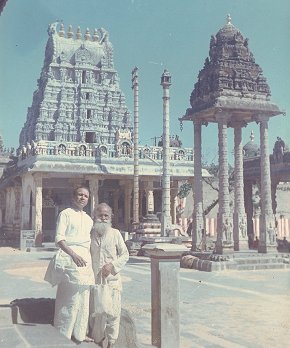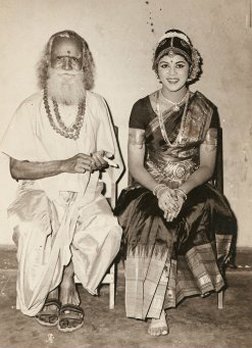Narthaki

News

Info

Featured


|
 |
Shuddha Nrittam - Dr. Sunil Kothari e-mail: sunilkothari1933@gmail.com February 8, 2009 Mangudi Durairaj Iyer (MDI) revived Shuddha Nrittam incorporating all the fundamental tenets of the art of pure dance. He was fully equipped to do so, with more than fifty years of experience. Few know that like many young men in the first quarter of the last century, he was enamoured of stage plays and photography. He went to Kolkata, impressed film director Raja Sandow and joined films there. Eventually, he landed in the Gemini Studios, Chennai. But art in cinema was nothing but a commercial commodity. The maestro from Mangudi (a village about 12kms from Kumbakonam in Tamilnadu) was dissatisfied with the bondage of the business oriented art.  MDI studied the various aspects of dance and music from his father Ramanath Bhagavatar. Mridangam lessons were from Anganna Naicker of Tanjore and then from Vaidyanatha Iyer. He studied classical dance from Melattur Natesa Iyer. He wrote two 'teach yourself' books: Mridanga Swabodhini (1939) and Swabodha Bharata Navaneetam (1957) which were published by dancer Revathi Ramachandran's grandfather. MDI started giving lessons and taught two sisters Kanchana and Gowri when they were nine and eight years old. Meena, an aunt of Revathi came under the tutelage of the guru at the age of seven.  At Cheyyur Sengalvarayar temple at Chingelput district in Tamilnadu, during the annual Brahmotsavam, Cheyyur Sarada, a devadasi attached to the temple performed Shuddha Nrittam, as one of the 72 items offered to the Lord. The 72 items included Kavita, Nritta, Vadya and Sangeeta. MDI saw this and he resurrected Shuddha Nrittam at the suggestion of late Prof. Sambamurthy, who presented some of these items at the Thiruchendur Murugan temple in 1969. According to late scholar and historian Dr. Arudra, Shuddha Nrittam has roots in Bhagavata Mela Nataka. He has observed: "Akin to Kuchipudi, the Melattur bani retains the rhythmic rhetoric and graceful grammar of Andhra Natyam as expounded by Nrittaratnavali of Jayasenapati. At one time, both Kuchipudi and Melattur styles were treated as rough and rustic dances. Mangudiyar was not ashamed of his heritage, and proudly discovered the dance on the inverted pots and named it as 'Panda-aranga-k-koothu,' now popularly known as Perani. He taught the intricacies to Kanchana and Gowri and reserved for Revathi, Shuddha Nrittam composing complicated vadyaprabandha for her dance." He founded Chidananda Natyamandali and coached many students. He taught some select items to senior dancers like Roshan Vajifdar, Yamini Krishnamurti and Pushpa Bhuyan, who, very few know was one of the pioneer dancers of Sattriya dance form. Another speciality of the guru was that he played mridangam for the recitals of his disciples. In 1980, when he realized that his end was nearing, he bequeathed Shuddha Nrittam in five gati-s to Revathi Ramachandran. He was her spiritual guru also. After her guru's demise she has been performing not only Shuddha Nrittam in five gati-s but many other numbers. Revathi distributes the fruits of the uncommon Mangudiyar style. The guru did not believe in stamping the feet hard but insisted on keeping the tempo and let the sound of the bells indicate the tala. However, in recent times, the accent is on raising the sound by stamping the feet hard. What is fascinating is there are pancha nadais and Gati bhedas. Every jati in the Varnam pattern has Gati bhedam. AP Haridoss, who is a mridangam disciple of Mangudiyar, has set some of the jati patterns after the demise of the guru. Recently it has been percussionist NK Kesavan who has been working on this aspect. Many felt that Shuddha Nrittam has resemblance with Kathak dance of North India. The tatkar, the footwork of Kathak and Shuddha Nrittam may appear to have common elements of padapatanam, striking the floor with feet recreating the mnemonic syllables of the percussion instruments. But Shuddha Nrittam is an indigenous independent art with all its shastric sanctions. It would be wrong to say that Shuddha Nrittam has been inspired or derived from Kathak. Both are different, in spite of the common elements of padapatanam. Dr. Sunil Kothari, dance historian, scholar, author, is a renowned dance critic. He is a regular contributor to Dance Magazine, New York. Dr. Kothari is a globetrotter, attending several national, international dance conferences and dance festivals. He has to his credit more than 14 definitive works on Indian classical dance forms. Kothari was a Fulbright Professor and has taught at the Dance Department, New York University; has lectured at several Universities in USA, UK, France, Australia, Indonesia and Japan. He has been Vice President of World Dance Alliance Asia Pacific (2000-2008) and is Vice President of World Dance Alliance Asia Pacific India chapter, based in New Delhi. A regular contributor to narthaki.com, Dr Kothari is honored by the President of India with the civil honor of Padma Shri and Sangeet Natak Akademi award. |